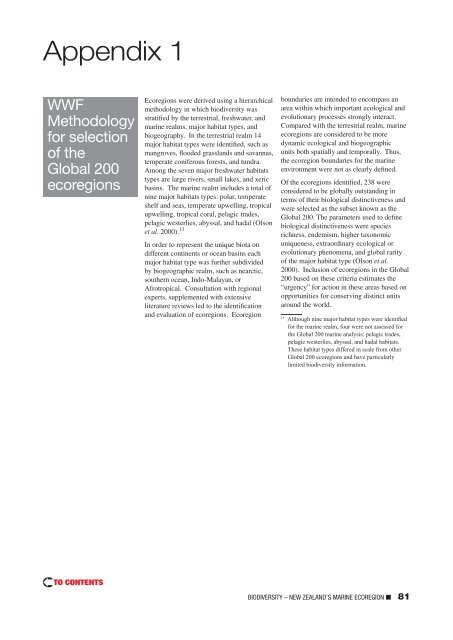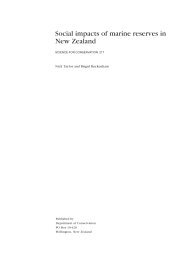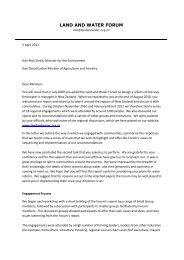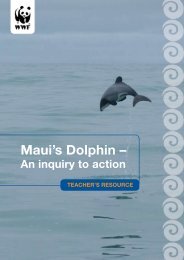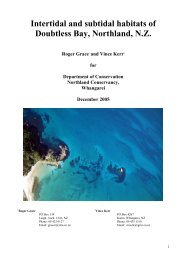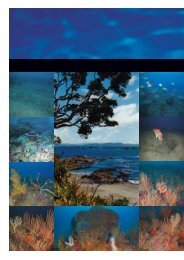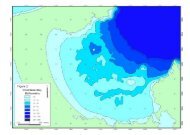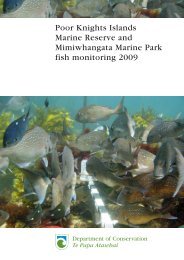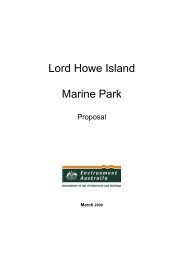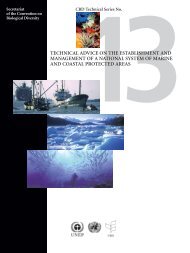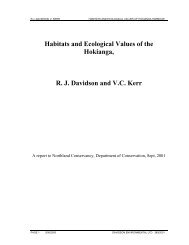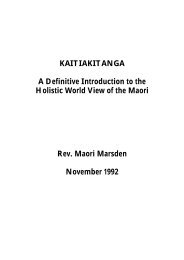WWF Shining a spotlight on the biodiversity of ... - MarineNZ.org.nz
WWF Shining a spotlight on the biodiversity of ... - MarineNZ.org.nz
WWF Shining a spotlight on the biodiversity of ... - MarineNZ.org.nz
You also want an ePaper? Increase the reach of your titles
YUMPU automatically turns print PDFs into web optimized ePapers that Google loves.
Appendix 1<br />
<str<strong>on</strong>g>WWF</str<strong>on</strong>g><br />
Methodology<br />
for selecti<strong>on</strong><br />
<strong>of</strong> <strong>the</strong><br />
Global 200<br />
ecoregi<strong>on</strong>s<br />
Ecoregi<strong>on</strong>s were derived using a hierarchical<br />
methodology in which <strong>biodiversity</strong> was<br />
stratified by <strong>the</strong> terrestrial, freshwater, and<br />
marine realms, major habitat types, and<br />
biogeography. In <strong>the</strong> terrestrial realm 14<br />
major habitat types were identified, such as<br />
mangroves, flooded grasslands and savannas,<br />
temperate c<strong>on</strong>iferous forests, and tundra.<br />
Am<strong>on</strong>g <strong>the</strong> seven major freshwater habitats<br />
types are large rivers, small lakes, and xeric<br />
basins. The marine realm includes a total <strong>of</strong><br />
nine major habitats types: polar, temperate<br />
shelf and seas, temperate upwelling, tropical<br />
upwelling, tropical coral, pelagic trades,<br />
pelagic westerlies, abyssal, and hadal (Ols<strong>on</strong><br />
et al. 2000). 13<br />
In order to represent <strong>the</strong> unique biota <strong>on</strong><br />
different c<strong>on</strong>tinents or ocean basins each<br />
major habitat type was fur<strong>the</strong>r subdivided<br />
by biogeographic realm, such as nearctic,<br />
sou<strong>the</strong>rn ocean, Indo-Malayan, or<br />
Afrotropical. C<strong>on</strong>sultati<strong>on</strong> with regi<strong>on</strong>al<br />
experts, supplemented with extensive<br />
literature reviews led to <strong>the</strong> identificati<strong>on</strong><br />
and evaluati<strong>on</strong> <strong>of</strong> ecoregi<strong>on</strong>s. Ecoregi<strong>on</strong><br />
boundaries are intended to encompass an<br />
area within which important ecological and<br />
evoluti<strong>on</strong>ary processes str<strong>on</strong>gly interact.<br />
Compared with <strong>the</strong> terrestrial realm, marine<br />
ecoregi<strong>on</strong>s are c<strong>on</strong>sidered to be more<br />
dynamic ecological and biogeographic<br />
units both spatially and temporally. Thus,<br />
<strong>the</strong> ecoregi<strong>on</strong> boundaries for <strong>the</strong> marine<br />
envir<strong>on</strong>ment were not as clearly defined.<br />
Of <strong>the</strong> ecoregi<strong>on</strong>s identified, 238 were<br />
c<strong>on</strong>sidered to be globally outstanding in<br />
terms <strong>of</strong> <strong>the</strong>ir biological distinctiveness and<br />
were selected as <strong>the</strong> subset known as <strong>the</strong><br />
Global 200. The parameters used to define<br />
biological distinctiveness were species<br />
richness, endemism, higher tax<strong>on</strong>omic<br />
uniqueness, extraordinary ecological or<br />
evoluti<strong>on</strong>ary phenomena, and global rarity<br />
<strong>of</strong> <strong>the</strong> major habitat type (Ols<strong>on</strong> et al.<br />
2000). Inclusi<strong>on</strong> <strong>of</strong> ecoregi<strong>on</strong>s in <strong>the</strong> Global<br />
200 based <strong>on</strong> <strong>the</strong>se criteria estimates <strong>the</strong><br />
“urgency” for acti<strong>on</strong> in <strong>the</strong>se areas based <strong>on</strong><br />
opportunities for c<strong>on</strong>serving distinct units<br />
around <strong>the</strong> world.<br />
13<br />
Although nine major habitat types were identified<br />
for <strong>the</strong> marine realm, four were not assessed for<br />
<strong>the</strong> Global 200 marine analysis: pelagic trades,<br />
pelagic westerlies, abyssal, and hadal habitats.<br />
These habitat types differed in scale from o<strong>the</strong>r<br />
Global 200 ecoregi<strong>on</strong>s and have particularly<br />
limited <strong>biodiversity</strong> informati<strong>on</strong>.<br />
BIODIVERSITY – NEW ZEALAND’S MARINE ECOREGION ■ 81


